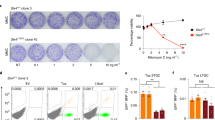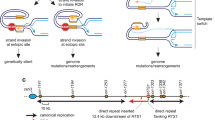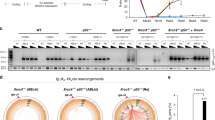Abstract
XP variant (XP-V) cells lack the damage-specific polymerase η and exhibit prolonged replication arrest after UV irradiation due to impaired bypass of UV photoproducts. To analyse the outcome of the arrested replication forks, homologous recombination (HR, Rad51 events) and fork breakage (Rad50 events) were assayed by immunofluorescent detection of foci-positive cells. Within 1 h of irradiation, XP-V cells showed more Rad51-positive cells than normal cells, while neither cell type showed an increase in Rad50 foci. Beyond 1 h, the frequency of Rad51-positive cells reached similar levels in both cell types, then declined at higher UV doses. At these later times, Rad50-positive cells increased with dose and to a greater extent in XP-V cells. Few cells were simultaneously positive for both sets of foci, suggesting a mutually exclusive recruitment of recombination proteins, or that these pathways operate at different stages during S phase. Analysis of cells containing a vector of tandemly arranged enhanced green fluorescent protein genes also showed that UV-induced HR was higher in XP-V cells. These results suggest that cells make an early commitment to HR and that at later times a subset of arrested forks degrade into double-strand breaks, two alternative pathways that are greater in XP-V cells.
This is a preview of subscription content, access via your institution
Access options
Subscribe to this journal
Receive 50 print issues and online access
$259.00 per year
only $5.18 per issue
Buy this article
- Purchase on SpringerLink
- Instant access to full article PDF
Prices may be subject to local taxes which are calculated during checkout





Similar content being viewed by others
References
Bollag RJ, Waldman AS and Liskay RM . (1989). Annu. Rev. Genet., 23, 199–225.
Broughton BC, Cordonnier A, Kleijer WJ, Jaspers NG, Fawcett H, Raams A, Garritsen VH, Stary A, Avril MF, Boudsocq F, Masutani C, Hanaoka F, Fuchs RP, Sarasin A and Lehmann AR . (2002). Proc. Natl. Acad. Sci. USA, 99, 815–820.
Buchhop S, Gibson MK, Wang XW, Wagner P, Sturzbechter H-W and Harris CW . (1997). Nucleic Acids Res., 25, 3868–3874.
Cleaver JE, Afzal V, Feeney L, McDowell M, Sadinski W, Volpe JPG, Busch D, Yu Y, Nagasawa H and Little JB . (1999). Cancer Res., 59, 1102–1108.
Cleaver JE, Bartholomew J, Char S, Crowley E, Feeney L and Limoli CL . (2002). DNA Repair, 3, 1–17.
Cleaver JE and Thomas GH . (1988). J. Invest. Derm., 90, 467–471.
Cordeiro-stone M, Makhov AM, Zaritskaya LS and Griffith JD . (1999). J. Mol. Biol., 289, 1207–1218.
Cordeiro-Stone M, Zaritskaya LS, Price LK and Kaufmann WK . (1997). J. Biol. Chem., 272, 13945–13954.
Godwin AR, Bollag RJ, Christie DM and Liskay RM . (1994). Proc. Natl. Acad. Sci. USA, 91, 12554–12558.
Johnson RE, Kondratick CM, Prakash S and Prakash L . (1999). Science, 264, 263–265.
Kannouche P, Broughton BC, Volker M, Hanaoka F, Mullenders LH and Lehmann AR . (2001). Genes Dev., 15, 158–172.
Kannouche P, Fernandez de Henestrosa AR, Coull B, Vidal AE, Gray C, Zicha D, Woodgate R and Lehmann AR . (2003). EMBO J., 22, 1223–1233.
Laposa RR, Feeney L and Cleaver JE . (2003). Cancer Res., 63, 3909–3912.
Lehmann AR, Kirk-Bell S, Arlett CF, Paterson MC, Lohman PHM, Weerd-Kastelein EAd and Bootsma D . (1975). Proc. Natl. Acad. Sci. USA, 72, 219–235.
Li Z, Xiao W, McCormick JJ and Maher VM . (2002). Proc. Natl. Acad. Sci. USA, 99, 4459–4464.
Limoli CL, Giedzinski E, Bonner WM and Cleaver JE . (2002a). Proc. Natl. Acad. Sci. USA, 99, 233–238.
Limoli CL, Giedzinski E, Morgan WF and Cleaver JE . (2000). Proc. Natl. Acad. Sci. USA, 97, 7939–7946.
Limoli CL, Laposa R and Cleaver JE . (2002b). Mutat. Res., 510, 121–129.
Linke SP, Sengupta S, Khabie N, Jeffries BA, Buchhop S, Miska S, Henning W, Pedeux R, Wang XW, Hofseth LJ, Yang Q, Garfield SH, Sturzbecher HW and Harris CC . (2003). Cancer Res., 63, 2596–2605.
Maser RS, Monsen KJ, Nelms BE and Petrini JH . (1997). Mol. Cell. Biol., 17, 6087–6096.
Masutani C, Kusumoto R, Yamada A, Dohmae N, Yokol M, Yuasa M, Araki M, Iwa S, Takio K and Hanoaka F . (1999). Nature, 399, 700–704.
Painter RB . (1980). Mutat. Res., 70, 337–341.
Park SD and Cleaver JE . (1979a). Nucleic Acids Res., 6, 1151–1159.
Park SD and Cleaver JE . (1979b). Proc. Natl. Acad. Sci. USA, 76, 3927–3931.
Paull TT, Rogakou EP, Yamazaki V, Kirchgessner CU, Gellert M and Bonner WM . (2000). Curr. Biol., 10, 886–895.
Petrini JHJ and Stracker TH . (2003). Trends Cell Biol., 13, 458–462.
Robison JG, Elliott J, Dixon K and Oakley GG . (2004). J. Biol. Chem., 279, 34802–34810.
Rogakou EP, Pilch DR, Orr AH, Ivanova VS and Bonner WM . (1998). J. Biol. Chem., 273, 5858–5868.
Saintigny Y, Delacote F, Vares G, Petitot F, Lambert S, Averbeck D and Lopez BS . (2001). EMBO J., 20, 3861–3870.
Saintigny Y and Lopez BS . (2002). Oncogene, 21, 488–492.
Scully R, Puget N and Vlasakova K . (2000). Oncogene, 19, 6176–6183.
Taghian DG and Nickoloff JA . (1997). Mol. Cell. Biol., 17, 6386–6393.
Thakur M, Wernick M, Collins C, Limoli C, Crowley E and Cleaver JE . (2001). Genes Chrom. Cancer, 32, 222–235.
Tsujimura T, Maher VM, Godwin AR, Liskay RM and McCormick JJ . (1990). Proc. Natl. Acad. Sci. USA, 87, 1566–1570.
Wang Y, Cortez D, Yazdi P, Neff N, Elledge SJ and Qin J . (2000). Genes Dev., 14, 927–939.
Zou L, Cortez D and Elledge SJ . (2002). Genes Dev., 16, 198–208.
Zou L and Elledge SJ . (2003). Science, 300, 1542–1548.
Acknowledgements
The work described here was supported by the following grants: American Cancer Society RPG-00-036-01-CNE and NASA NAG2-1632 (to CLL); the National Institutes of Environmental Health Sciences grant 1 RO1 ES 8061 and the Ellison Senior Scholar Award (to JEC). We are also grateful to the XP Society, Poughkeepsie, NY, for their continued support and encouragement to one of us (JEC). We thank Dr William Hyun, Molecular Diagnostics, UCSF Cancer Center, for assistance in immunofluorescence.
Author information
Authors and Affiliations
Rights and permissions
About this article
Cite this article
Limoli, C., Giedzinski, E. & Cleaver, J. Alternative recombination pathways in UV-irradiated XP variant cells. Oncogene 24, 3708–3714 (2005). https://doi.org/10.1038/sj.onc.1208515
Received:
Revised:
Accepted:
Published:
Issue Date:
DOI: https://doi.org/10.1038/sj.onc.1208515
Keywords
This article is cited by
-
No Formation of DNA Double-Strand Breaks and No Activation of Recombination Repair with UVA
Journal of Investigative Dermatology (2011)
-
Pol η is required for DNA replication during nucleotide deprivation by hydroxyurea
Oncogene (2007)
-
Cancer in xeroderma pigmentosum and related disorders of DNA repair
Nature Reviews Cancer (2005)



